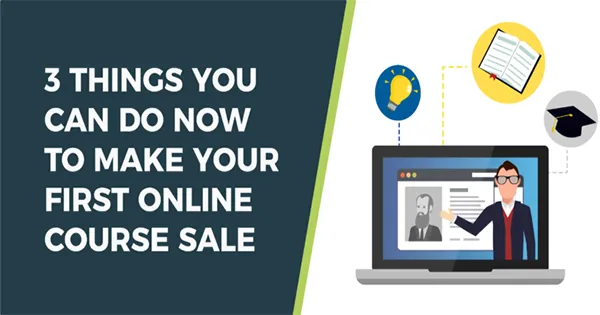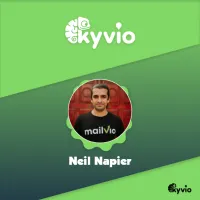Kyvio Blog - Lead Generation

How to Attract and Engage an Audience for Your Online Course
So your online course is all set up, and you can’t wait to get students on board. Everything feels so exciting. You have prepared and waited for this for so long. And you are thrilled about launching your first class as soon as possible.
But the problem is that creating the best course ever is one thing. But acquiring an online course audience is a whole different thing.
Considering the high rates of online courses dropouts, acquiring students and keeping them can be a real challenge. It turns out that the average online course completion rates are nearly 13%. This means that once you get some ten students on board, only one of them will complete your online course.

So, after you finish creating the course, there are two main questions you need to sort out:
How to find the right online course audience?
How to make my audience opt for your class?
Let’s start by exploring the art of getting your first students for your online course. Let me share with you three steps you should take to bring in your first student.
Step 1: Build Authority and Trust
So, the first question to ask yourself is “how to find the right audience for my online course?” In other words, you should aim to find out how to attract the adequate audience and quality leads. You don’t want to end up with a bunch of people who would subscribe but then bounce after a couple of days.
When teaching a course – whether traditional or online – it is all about having a room full of people who trust you. And by this, I mean that they should not only place confidence in you as a person but also as a professional.
In other words, your online course audience should see you as a credible authority and professional.
In this respect, it’s vital to convince these people that you are the right teacher for them. And that your course is one of the best courses they could ever take. You should also prove that you have some valuable and scarce knowledge to offer. You will need to communicate your competitive advantage.
Building credibility towards you as a person and as an expert won’t be easy. But it’s not impossible either. Make sure to arm yourself with patience, and work your way towards the course of your dreams.
If you aspire to build a solid reputation in your niche, then start giving away bits and pieces of knowledge for free. I am not saying you have to divide your whole course into chunks and share it all for free. That would be disastrous for you as someone who is trying to do business through teaching.
You will instead need to give something up for free to prove your expertise and gain the trust of your online course audience. You need to give them a taste of your product and make them want more.
RELATED: 3 Ways to Squeeze More Content Out of Your Course.
So, make sure to start from the ground floor to be able to reach the rooftop of that skyscraper. Here are a few ways you can provide value to your online course audience without giving away everything:
Launch a website/start blogging
Before you start writing, think about your potential students. Ask yourself these questions:
Who is going to pick up my online course?
Who might be the most and least interested in my course?
Where do these people hang out online (Twitter, Facebook, Instagram, Quora, etc.)?
What keywords are they using to search for similar online courses? (Using tools like Moz keyword search)
Start doing your little market research to better understand your target. Once you get your “buyer persona” or “avatar” start gathering relevant keywords. Based on those, look up the most popular posts out there around your topic.
Then, you can start brainstorming and drafting your content.
Write about things that are relevant to your potential students. For example, if your course is about .Net/C#, write something like “10 things a beginner .Net developer should know.” Or “how to prepare for a .Net developer job interview.” Make sure to produce content that your online course audience would relate to and want to learn more about.
See? I am not telling you to display all your knowledge free of charge on the Internet. I am telling you to have your own space on the Internet where you can exhibit your expertise. It can be a website or a blog or both. Once you have it, start providing your audience with valuable content. Content that will nurture their trust and loyalty. But also content that will build upon your credibility and authority.
If you feel you are not much into writing, try to start a podcast or a YouTube channel. Video and audio content have also proven to be very popular and engaging.
Be active on social media channels
This doesn’t mean you should be active on all social media channels out there. Look for the social platforms where your prospects hang out and make sure to spend some timee there.
This is a highly efficient way of finding like-minded people. As well as building a good community of followers and supporters.
Network with people in real-life
No, this is not an old-fashioned way of acquiring students or supporters. In fact, a big portion of students relies heavily on the advice of their peers when choosing an online course.
So, take your chance of meeting with these people in person. Attend community events, join groups, form alliances with peer teachers, cross-promote each other. Get your name heard out there!
Step 2: Keep your Online Course Audience in The Loop With a Newsletter
An email newsletter will help you connect with your potential students. It will keep them warm until you introduce your online course to them.
That said, it’s vital to send emails to your readers regularly.
But you would ask me how do I get their contact info if I don’t even have an audience yet. Well, it’s simple, give them an incentive to give their personal information.
People will give their email address only if you give back something in return. And that’s what lead magnets are for. In your blog, website or podcast, set up a lead magnet that will compel people to give out their emails.
You’ll need to provide them with some valuable content to be able to retrieve their emails. It can be a checklist, an ebook, an excel sheet with useful information. Give away anything that will be useful and will most likely respond to their needs.
After setting up your optin form, you’ll need to create an attractive landing page and a thank you page. You can learn in more details how to set up high converting multiple step funnels in this article.
And after you smoothly carry your visitors through your funnel, you got it. Your email list is ready.
After you get their contact information, you can start engaging with your subscribers. But make sure to keep things organized and in control. Don’t send out too many freebies and don’t reach out too often. You don’t want to look spammy, do you?
Building an email list is important because it allows you to stay in touch with your potential students. It allows you share more content with them and nurture more credibility and trust.
Make sure to send out valuable content that will make your prospects trust and believe in your expertise. that will make the next step much easier.
Step 3: Present an Irresistible Offer to your Prospects
Now that you have done so much in engaging with your online course audience, it’s time to present your course and offer them to jump in.
If you’ve done everything we mentioned the right way, chances are you already got yourselves some quality leads.

At this stage, you need to give people irresistible incentives to join your class. That could be discount codes, exclusive offers, or coupons for your online course. A very efficient way of getting people to jump on these offers is to make them temporary. Add a timer to your offer, and watch people get excited about your product like never before.
You can refer to this article to learn how to create irresistible offers to sell your products.
Summing up
It’s essential that you don’t expect all this to happen overnight.
We all know there is no overnight success.
However, if you want to get students for your online course, you might as well want to work on it hard enough.
The key takeaways are the following:
Think long-term
Provide bits and pieces of valuable content to your audience
Do not limit yourself with blog posts, create audio and video content
Meet people, cross-promote each other, network
Collect emails and set up an email newsletter
Use lead magnets to convert people
Offer coupon codes and discounts to your loyal followers and supporters
And last but not least, it’s vital not to let go of your students once they have jumped on board. Keep engaging them because after all, keeping existing customers is much cheaper than getting new ones.
You might want to launch a new course, and they will need them to be happy about their first experience with you.
So make sure to continue providing your online course audience with valuable content. Be interesting and engaging. Also, always keep the communication going.
Did you know that you can achieve all of the steps above using one tool? Kyvio helps you keep all parts of your business in one place. Create your online course, manage your subscribers, and send out your newsletter emails all from one platform.



